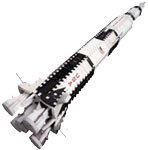Apollo 11

test
In order for the Apollo 11 to cross the distance that separates the Earth from the Sea of Tranquility, NASA needed to create the biggest rocket ever: the Saturn V Used 13 times between 1968 and 1973, it was the mighty power of this enormous launcher that allowed ships weighing over 140 tons to be propelled into space. Measuring 110 meters (360 feet) the rocket weighed 2,700 tons at take-off, but a large portion of its weight was made up of fuel. The rocket consisted of three stages, each equipped with motors that gave the rocket the necessary boost to lift off from the platform, accelerate and then go into orbit. The upper third part of the rocket held the Service Module, the Lunar Module and the Apollo 11 Command Module. The barrel-shaped Service Module supplied oxygen, water and electricity to the crew during the voyage. Situated at the apex of the rocket, the Command Module enclosed the 600 or so controls necessary to navigate the ship.
A trip well worth the detour!
The progress and innovations generated by the conquest of
space are
abundant. The pacemaker, numeric image, digital display,
miniature
camera and the scanner are but a few of the some 30,000
different
inventions that have seen the day because of the Apollo
missions. It
has been estimated that for every dollar invested in the Lunar
landing Program there was return of approximately nine dollars
on
Earth.
